Corporate ¤ Home ¤ License ¤ Memory ¤ MIPs ¤ Performance ¤ Products ¤ Prices |
|
Performance Measurements
This page presents performance measurements for modem and telephony components in the presence of various channel impairments. These measurements were taken from both VSIM simulations and on real-time hardware using the Telecom Analysis Systems TAS-122 Telephone Network Simulator.
[Caller ID][Call Progress][DTMF/MF][Dynamic Range][V.42][V.42bis][Wireless BER]
Telecom Modem Composite BER Curves
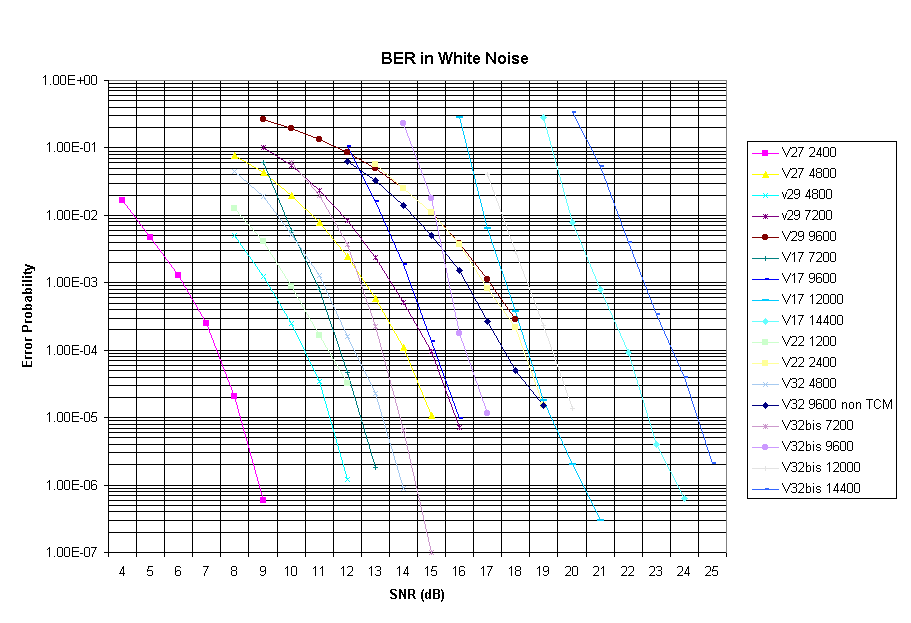
Notes:
FAX Modem BER Curves in Gain Distortion and Noise
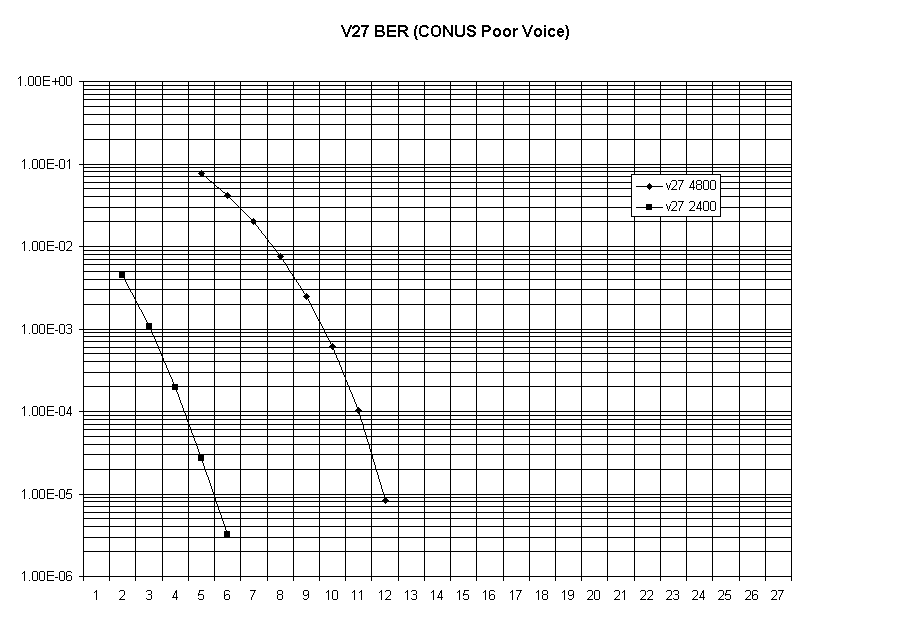
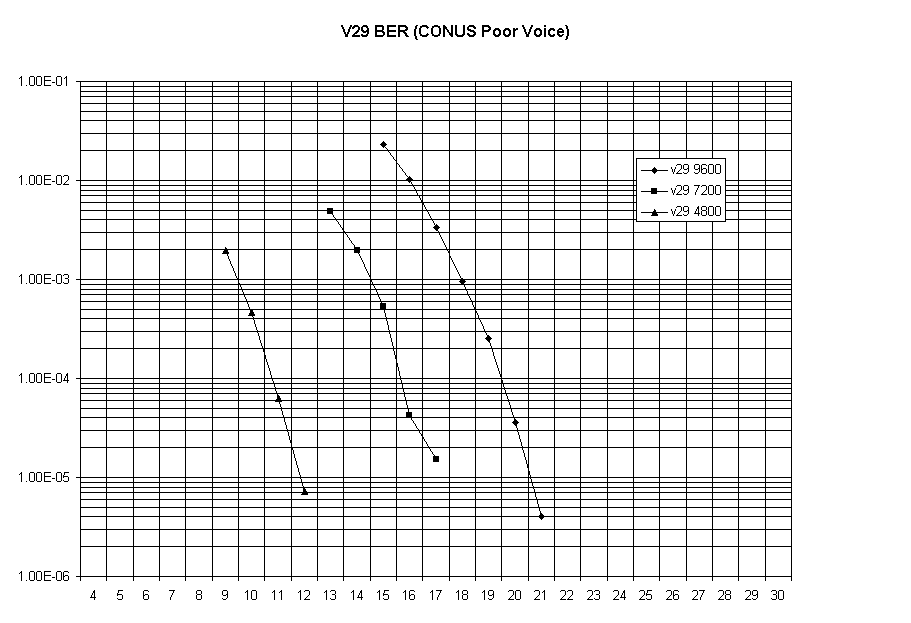
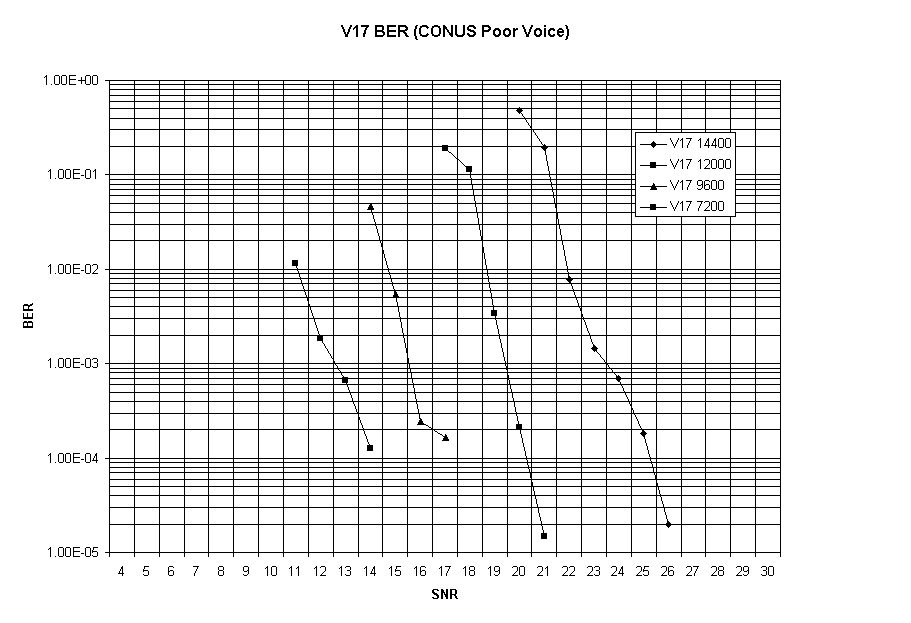
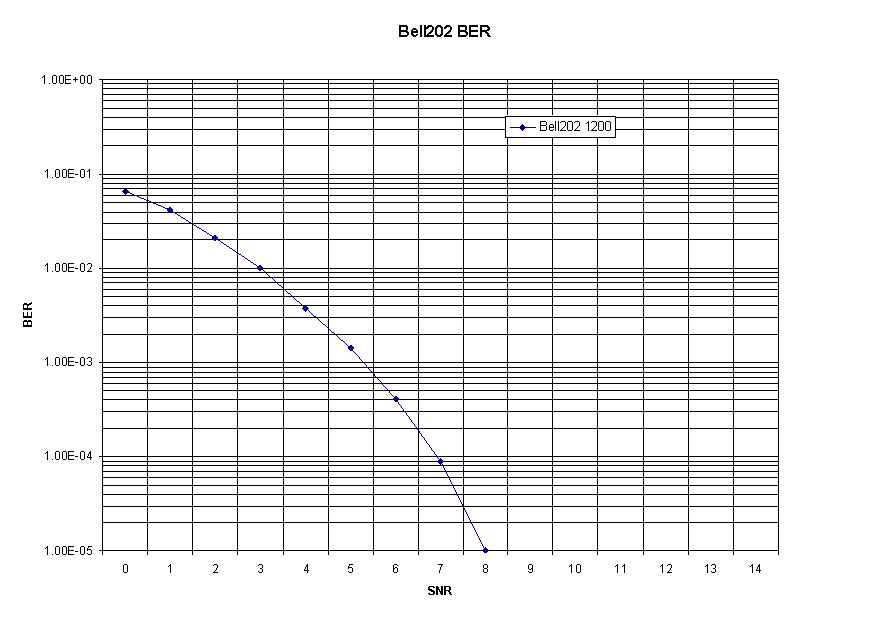
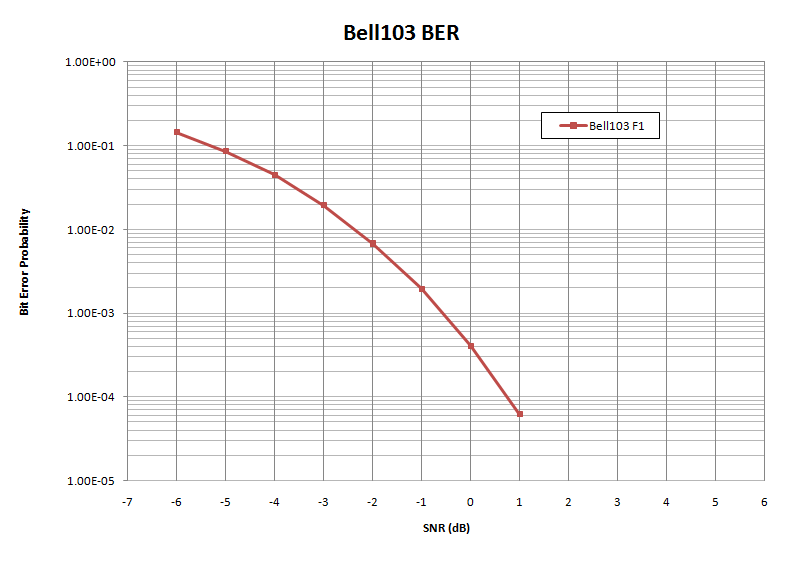
Notes:
Telecom Modem Acquisition, Dynamic Range, and Carrier Offset
| Modem | Burst Acquisition (%) | Dynamic Range Min/Max (dB) | Carrier Frequency Offset (Hz) |
| Baudot TTY | 100 | -42 to -3 | -15 to +30 |
| Bell103 | 100 | -47 to -3 | -40 to +50 |
| Bell202 | 100 | -47 to -3 | -40 to +50 |
| Bell212 | 100 | -47 to -10 | -10 to +10 |
| V.17 | 100 | -47 to -8 | -40 to +40 |
| V.21 | 100 | -48 to -4 | -19 to +12 |
| v.22bis | 100 | -47 to -10 | -10 to +10 |
| V.23 | 100 | -48 to -6 | -19 to +16 |
| v.26 | 100 | -48 to -5 | -10 to +40 |
| v.27 | 100 | -47 to -5 | -10 to +40 |
| v.29 | 100 | -48 to -8 | -10 to +40 |
| v.32bis/v.32 | 100 | -47 to -10 | -10 to +40 |
Notes:
Representative Sample of Fax Machines Tested
| Audiovox AFX 3500 Brother Intelifax 680 Brother MFC 1750 Fujitsu DEX Express 6000 Fujitsu DEX X530 Genoa Fax Analyzer Gray Associates Fax Analyzer HP FAX-200 Lanier Faxwriter 2400 |
Mitafax LDC-650 Murata M1200 Muratec M910 NEC NECFAX 340 NEC NECFAX 461 NEC NECFAX 480 OKI Fax 650 Panasonic KX-F130 Richo Fax15 |
Samsung FX1700 Sanyo Sanfax 80 SHARP FO-135 Sharp UX-116 Toshiba Xerox Telecopier 7018 |
Representative Sample of Data Modems Tested
|
3Com Etherlink LAN+28.0 Modem |
Intel Satisfaction 14.4 Kingston PCMCIA Megahertz 14.4 PCMCIA Microcom Deskporte 288.8S Microcom Deskporte 488S Microcom Deskporte Fast MNP10 Microcom Deskporte Fast QX-4232 Motorola ModemSurfr Motorola ModemSurfr 33.6 Motorola UDS Modem Blaster Flash 56k Multimodem 19.2 |
Practical Peripherals PM144MT II Practical Peripherals PM288 MPSI Supra Express 56k Supra Diamond 56k TDK Cyberexpress 3000 USR Sportster 14,400 USR Sportster 28,800 USR Sportster 33,600 Faxmodem USR Sportster v.90 Faxmodem Xircom RealPort Modem 56k Zoom Faxmodem 56kx Zoom VFX28.8 |
Notes:
GenDet Call Progress Detector Performance
| Parameter | Time - Cadence-Based (default) | Time - North American |
| Tone Detect time | 92 msec. | 52 msec. |
| Resolve DIALTONE time | 2.0 sec. | 52 msec. |
| DIALTONE release time | 0.4 sec. | 52 msec. |
| Resolve RINGBACK time | 2.8 sec. | 52 msec. |
| RINGBACK release time | 0.8 sec. | 52 msec. |
| Resolve BUSY time | 2.4 sec. | 52 msec. |
| BUSY release time | 0.8 sec. | 52 msec. |
| Resolve REORDER time | 2.6 sec. | 52 msec. |
| REORDER release time | 0.8 sec. | 52 msec. |
| Parameter | Cadence-Based (default) | North American |
| Tone Detect frequency range | 250 Hz to 750 Hz | 350 Hz to 620 Hz |
| Tone Detect dynamic range | -6 dBm to -43 dBm | -6 dBm to -43 dBm |
Network Tones Tested for Various Countries
|
Country |
Dial Tone |
Ring-back |
Busy |
Congestion |
|
Australia |
400 Hz + 450 Hz continuous |
425 Hz, 0.4s ON, 0.2s OFF, then 0.4s ON, 2.0s OFF |
425 Hz, 0.375s ON, 0.375s OFF |
425 Hz, 0.375s ON, 0.375s OFF
|
|
Austria |
400 Hz to 490 Hz continuous |
400 Hz to 490 Hz, 1.0s ON, 5.0s OFF |
400 Hz to 490 Hz, 0.3s ON, 0.3s OFF |
400 Hz to 490 Hz, 0.2s ON, 0.2s OFF |
|
Belgium |
450 Hz continuous |
450 Hz, 1.0s ON, 3.0s OFF |
450 Hz, 0.5s ON, 0.5s OFF |
450 Hz, 0.167s ON, 0.167s OFF |
|
Brazil |
425 Hz continuous |
425 Hz, 1.0s ON, 4.0s OFF |
425 Hz, 0.25s ON, 0.25s OFF |
425 Hz, 0.25s ON, 1.0s OFF
|
|
Britain |
400 Hz + 450 Hz continuous |
400 Hz + 450 Hz, 0.35s ON, 0.22s OFF, then 0.4s ON, 0.2s OFF, 0.4s ON, 2.0s OFF |
400 Hz, 0.375s ON, 0.375s OFF |
400 Hz, 0.35s ON, 0.225s OFF |
|
Canada |
350 Hz + 440 Hz continuous |
440 Hz + 480 Hz, 2.0s ON, 4.0s OFF |
480 Hz + 620 Hz, 0.5s ON, 0.5s OFF |
480 Hz + 620 Hz, 0.25s ON, 0.25s OFF |
|
Czech. Republic |
370 Hz to 500 Hz continuous |
370 Hz to 500 Hz, 1.0s ON, 4.0s OFF |
425 Hz, 0.33s ON, 0.33s OFF |
425 Hz, 0.16s ON, 0.16s OFF |
|
Denmark |
425 Hz continuous |
425 Hz, 0.25s ON, 0.25s OFF |
425 Hz, 0.25s ON, 0.25s OFF |
|
|
Finland |
425 Hz continuous |
425 Hz, 0.3s ON, 0.3s OFF |
425 Hz, 0.2s ON, 0.2s OFF |
|
|
France |
440 Hz continuous |
440 Hz, 1.5s ON, 3.5s OFF |
440 Hz, 0.5s ON, 0.5s OFF |
440 Hz, 0.5s ON, 0.5s OFF |
|
Germany |
425 Hz continuous |
425 Hz, 1.0s ON, 4.0s OFF |
425 Hz, 0.48s ON, 0.48s OFF |
425 Hz, 0.24s ON, 0.24s OFF |
|
Greece |
450 Hz continuous |
450 Hz, 0.3s ON, 0.3s OFF |
450 Hz, 0.3s ON, 0.3s OFF |
|
|
Hungary |
425 Hz continuous |
425 Hz, 0.3s ON, 0.3s OFF |
425 Hz, 0.3s ON, 0.3s OFF |
|
|
Iceland |
400 Hz to 450 Hz continuous |
425 Hz, 0.25s ON, 0.25s OFF |
425 Hz, 0.25s ON, 0.25s OFF |
|
|
Ireland |
400 Hz + 450 Hz continuous |
400 Hz + 450 Hz, 2.0s ON, 4.0s OFF |
400 Hz + 450 Hz, 0.375s ON, 0.375s OFF |
400 Hz + 450 Hz, 0.375s ON, 0.375s OFF |
|
Italy |
425 Hz continuous 0.2s ON, 0.2s OFF, 0.6s ON, 1.0s OFF repeated |
425 Hz, 1.0s ON, 4.0s OFF |
425 Hz, 0.5s ON, 0.5s OFF |
425 Hz, 0.5s ON, 0.5s OFF |
|
Japan |
400 Hz continuous |
384 Hz + 416 Hz, 1.0s ON, 2.0s OFF |
400 Hz, 0.5s ON, 0.5s OFF |
400 Hz, 0.5s ON, 0.5s OFF |
|
Luxembourg |
380 Hz to 490 Hz continuous |
380 Hz to 490 Hz, 0.5s ON, 0.5s OFF |
380 Hz to 490 Hz, 0.5s ON, 0.5s OFF |
|
|
Mexico |
425 Hz continuous |
425 Hz, 1.0s ON, 4.0s OFF |
425 Hz, 0.25s ON, 0.25s OFF |
425 Hz, 0.25s ON, 0.25s OFF |
|
Norway |
425 Hz continuous |
425 Hz, 1.0s ON, 4.0s OFF |
425 Hz, 0.5s ON, 0.5s OFF |
425 Hz, 0.2s ON, 0.2s OFF |
|
Poland |
360 Hz to 450 Hz continuous |
|
360 Hz to 450 Hz, 0.5s ON, 0.5s OFF |
|
|
Portugal |
425 Hz continuous |
425 Hz, 1.0s ON, 5.0s OFF |
425 Hz, 0.5s ON, 0.5s OFF |
425 Hz, 0.2s ON, 0.2s OFF |
|
Spain |
425 Hz continuous |
425 Hz, 1.5s ON, 3.0s OFF |
425 Hz, 0.2s ON, 0.2s OFF |
425 Hz, 0.2s ON, 0.2s OFF |
|
Sweden |
425 Hz continuous |
425 Hz, 1.0s ON, 5.0s OFF |
425 Hz, 0.25s ON, 0.25s OFF |
425 Hz, 0.25s ON, 0.75s OFF |
|
Turkey |
450 Hz continuous |
450 Hz, 2.0s ON, 4.0s OFF |
450 Hz, 0.5s ON, 0.5s OFF |
450 Hz, 0.2s ON, 0.2s OFF |
|
USA |
350 Hz + 440 Hz continuous |
440 Hz + 480 Hz, 2.0s ON, 4.0s OFF |
480 Hz + 620 Hz, 0.5s ON, 0.5s OFF |
480 Hz + 620 Hz, 0.25s ON, 0.25s OFF |
Notes:
Bellcore/ETSI Caller ID Detector Performance
Table 2 - Group 1, CAS Recognition - All Parameters at Nominal Values
| Test # |
Low Freq. Tone HZ |
Low Freq. Tone Level dBm |
High Freq. Tone Hz |
High Freq. Tone Level dBm |
Twist Level dB |
CAS Duration ms |
Test Result per 100 bursts |
| 1 | 2130 | -22 | 2750 | -22 | 0 | 80 | 100% |
Table 3 - Group 2, CAS Recognition - One Parameter at a Time at the Extreme Value
| Test # |
Low Freq. Tone HZ |
Low Freq. Tone Level dBm |
High Freq. Tone Hz |
High Freq. Tone Level dBm |
Twist Level dB |
CAS Duration ms |
Test Result per 100 bursts |
| 2 | 2119.3 | -22 | 2750 | -22 | 0 | 80 | 100% |
| 3 | 2140.7 | -22 | 2750 | -22 | 0 | 80 | 100% |
| 4 | 2130 | -22 | 2736.2 | -22 | 0 | 80 | 100% |
| 5 | 2130 | -22 | 2763.8 | -22 | 0 | 80 | 100% |
| 6 | 2130 | -32 | 2750 | -32 | 0 | 80 | 100% |
| 7 | 2130 | -14 | 2750 | -14 | 0 | 80 | 100% |
| 8 | 2130 | -32 | 2750 | -26 | 0 | 80 | 100% |
| 9 | 2130 | -26 | 2750 | -32 | 0 | 80 | 100% |
| 10 | 2130 | -14 | 2750 | -20 | 0 | 80 | 100% |
| 11 | 2130 | -20 | 2750 | -14 | 0 | 80 | 100% |
| 12 | 2130 | -22 | 2750 | -22 | 0 | 75 | 100% |
| 13 | 2130 | -22 | 2750 | -22 | 0 | 80 | 100% |
Table 4 - Group 3, CAS Recognition - Parameters at 90% from Nominal, CAS 75.5 ms
| Test # |
Low Freq. Tone HZ |
Low Freq. Tone Level dBm |
High Freq. Tone Hz |
High Freq. Tone Level dBm |
Twist Level dB |
CAS Duration ms |
Test Result per 100 bursts |
| 14 | 2120.4 | -31 | 2737.6 | -31 | 0 | 75.5 | 100% |
| 15 | 2120.4 | -31 | 2762.4 | -31 | 0 | 75.5 | 100% |
| 16 | 2139.6 | -31 | 2737.6 | -31 | 0 | 75.5 | 100% |
| 17 | 2139.6 | -31 | 2762.4 | -31 | 0 | 75.5 | 100% |
| 18 | 2120.4 | -14.8 | 2737.6 | -14.8 | 0 | 75.5 | 100% |
| 19 | 2120.4 | -14.8 | 2762.4 | -14.8 | 0 | 75.5 | 100% |
| 20 | 2139.6 | -14.8 | 2737.6 | -14.8 | 0 | 75.5 | 100% |
| 21 | 2139.6 | -14.8 | 2762.4 | -14.8 | 0 | 75.5 | 100% |
| 22 | 2120.4 | -31 | 2737.6 | -25.6 | -5.4 | 75.5 | 100% |
| 23 | 2120.4 | -31 | 2762.4 | -25.6 | -5.4 | 75.5 | 100% |
| 24 | 2139.6 | -31 | 2737.6 | -25.6 | -5.4 | 75.5 | 100% |
| 25 | 2139.6 | -31 | 2762.4 | -25.6 | -5.4 | 75.5 | 100% |
| 26 | 2120.4 | -25.6 | 2737.6 | -31 | +5.4 | 75.5 | 100% |
| 27 | 2120.4 | -25.6 | 2762.4 | -31 | +5.4 | 75.5 | 100% |
| 28 | 2139.6 | -25.6 | 2737.6 | -31 | +5.4 | 75.5 | 100% |
| 29 | 2139.6 | -25.6 | 2762.4 | -31 | +5.4 | 75.5 | 100% |
| 30 | 2120.4 | -14.8 | 2737.6 | -20.2 | +5.4 | 75.5 | 100% |
| 31 | 2120.4 | -14.8 | 2762.4 | -20.2 | +5.4 | 75.5 | 100% |
| 32 | 2139.6 | -14.8 | 2737.6 | -20.2 | +5.4 | 75.5 | 100% |
| 33 | 2139.6 | -14.8 | 2762.4 | -20.2 | +5.4 | 75.5 | 100% |
| 34 | 2120.4 | -20.2 | 2737.6 | -14.8 | -5.4 | 75.5 | 100% |
| 35 | 2120.4 | -20.2 | 2762.4 | -14.8 | -5.4 | 75.5 | 100% |
| 36 | 2139.6 | -20.2 | 2737.6 | -14.8 | -5.4 | 75.5 | 100% |
| 37 | 2139.6 | -20.2 | 2762.4 | -14.8 | -5.4 | 75.5 | 100% |
Table 5 - Group 3, CAS Recognition - Parameters at 90% from Nominal, CAS 84.5 ms
| Test # |
Low Freq. Tone HZ |
Low Freq. Tone Level dBm |
High Freq. Tone Hz |
High Freq. Tone Level dBm |
Twist Level dB |
CAS Duration ms |
Test Result per 100 bursts |
| 38 | 2120.4 | -31 | 2737.6 | -31 | 0 | 84.5 | 100% |
| 39 | 2120.4 | -31 | 2762.4 | -31 | 0 | 84.5 | 100% |
| 40 | 2139.6 | -31 | 2737.6 | -31 | 0 | 84.5 | 100% |
| 41 | 2139.6 | -31 | 2762.4 | -31 | 0 | 84.5 | 100% |
| 42 | 2120.4 | -14.8 | 2737.6 | -14.8 | 0 | 84.5 | 100% |
| 43 | 2120.4 | -14.8 | 2762.4 | -14.8 | 0 | 84.5 | 100% |
| 44 | 2139.6 | -14.8 | 2737.6 | -14.8 | 0 | 84.5 | 100% |
| 45 | 2139.6 | -14.8 | 2762.4 | -14.8 | 0 | 84.5 | 100% |
| 46 | 2120.4 | -31 | 2737.6 | -25.6 | -5.4 | 84.5 | 100% |
| 47 | 2120.4 | -31 | 2762.4 | -25.6 | -5.4 | 84.5 | 100% |
| 48 | 2139.6 | -31 | 2737.6 | -25.6 | -5.4 | 84.5 | 100% |
| 49 | 2139.6 | -31 | 2762.4 | -25.6 | -5.4 | 84.5 | 100% |
| 50 | 2120.4 | -25.6 | 2737.6 | -31 | +5.4 | 84.5 | 100% |
| 51 | 2120.4 | -25.6 | 2762.4 | -31 | +5.4 | 84.5 | 100% |
| 52 | 2139.6 | -25.6 | 2737.6 | -31 | +5.4 | 84.5 | 100% |
| 53 | 2139.6 | -25.6 | 2762.4 | -31 | +5.4 | 84.5 | 100% |
| 54 | 2120.4 | -14.8 | 2737.6 | -20.2 | +5.4 | 84.5 | 100% |
| 55 | 2120.4 | -14.8 | 2762.4 | -20.2 | +5.4 | 84.5 | 100% |
| 56 | 2139.6 | -14.8 | 2737.6 | -20.2 | +5.4 | 84.5 | 100% |
| 57 | 2139.6 | -14.8 | 2762.4 | -20.2 | +5.4 | 84.5 | 100% |
| 58 | 2120.4 | -20.2 | 2737.6 | -14.8 | -5.4 | 84.5 | 100% |
| 59 | 2120.4 | -20.2 | 2762.4 | -14.8 | -5.4 | 84.5 | 100% |
| 60 | 2139.6 | -20.2 | 2737.6 | -14.8 | -5.4 | 84.5 | 100% |
| 61 | 2139.6 | -20.2 | 2762.4 | -14.8 | -5.4 | 84.5 | 100% |
Table 6 - Group 4, CAS Reject Amplitude
| Test # |
Low Freq. Tone HZ |
Low Freq. Tone Level dBm |
High Freq. Tone Hz |
High Freq. Tone Level dBm |
Twist Level dB |
CAS Duration ms |
Test Result per 100 bursts |
| 62 | 2130 | -46 | 2750 | -46 | 0 | 80 | 0% |
Notes:
Test Number and VSIM Command Line:
Test# 01: command line: vsim32 -vcasb -t-22 -OF10 -OF20 -twist0 -L640 -ocastst01.txt,d
Test# 02: command line: vsim32 -vcasb -t-22 -OF1-10.7 -OF20 -twist0 -L640 -ocastst02.txt,d
Test# 03: command line: vsim32 -vcasb -t-22 -OF110.7 -OF20 -twist0 -L640 -ocastst03.txt,d
Test# 04: command line: vsim32 -vcasb -t-22 -OF10 -OF2-13.8 -twist0 -L640 -ocastst04.txt,d
Test# 05: command line: vsim32 -vcasb -t-22 -OF10 -OF213.8 -twist0 -L640 -ocastst05.txt,d
Test# 06: command line: vsim32 -vcasb -t-32 -OF10 -OF20 -twist0 -L640 -ocastst06.txt,d
Test# 07: command line: vsim32 -vcasb -t-14 -OF10 -OF20 -twist0 -L640 -ocastst07.txt,d
Test# 08: command line: vsim32 -vcasb -t-32 -OF10 -OF20 -twist6 -L640 -ocastst08.txt,d
Test# 09: command line: vsim32 -vcasb -t-26 -OF10 -OF20 -twist-6 -L640 -ocastst09.txt,d
Test# 10: command line: vsim32 -vcasb -t-14 -OF10 -OF20 -twist-6 -L640 -ocastst10.txt,d
Test# 11: command line: vsim32 -vcasb -t-20 -OF10 -OF20 -twist6 -L640 -ocastst11.txt,d
Test# 12: command line: vsim32 -vcasb -t-22 -OF10 -OF20 -twist0 -L600 -ocastst12.txt,d
Test# 13: command line: vsim32 -vcasb -t-22 -OF10 -OF20 -twist0 -L680 -ocastst13.txt,d
Test# 14: command line: vsim32 -vcasb -t-31 -OF1-9.6 -OF2-12.4 -twist0 -L604 -ocastst14.txt,d
Test# 15: command line: vsim32 -vcasb -t-31 -OF1-9.6 -OF212.4 -twist0 -L604 -ocastst15.txt,d
Test# 16: command line: vsim32 -vcasb -t-31 -OF19.6 -OF21-2.4 -twist0 -L604 -ocastst16.txt,d
Test# 17: command line: vsim32 -vcasb -t-31 -OF19.6 -OF212.4 -twist0 -L604 -ocastst17.txt,d
Test# 18: command line: vsim32 -vcasb -t-14.8 -OF1-9.6 -OF2-12.4 -twist0 -L604 -ocastst18.txt,d
Test# 19: command line: vsim32 -vcasb -t-14.8 -OF1-9.6 -OF212.4 -twist0 -L604 -ocastst19.txt,d
Test# 20: command line: vsim32 -vcasb -t-14.8 -OF19.6 -OF21-2.4 -twist0 -L604 -ocastst20.txt,d
Test# 21: command line: vsim32 -vcasb -t-14.8 -OF19.6 -OF212.4 -twist0 -L604 -ocastst21.txt,d
Test# 22: command line: vsim32 -vcasb -t-31 -OF1-9.6 -OF2-12.4 -twist5.4 -L604 -ocastst22.txt,d
Test# 23: command line: vsim32 -vcasb -t-31 -OF1-9.6 -OF212.4 -twist5.4 -L604 -ocastst23.txt,d
Test# 24: command line: vsim32 -vcasb -t-31 -OF19.6 -OF21-2.4 -twist5.4 -L604 -ocastst24.txt,d
Test# 25: command line: vsim32 -vcasb -t-31 -OF19.6 -OF212.4 -twist5.4 -L604 -ocastst25.txt,d
Test# 26: command line: vsim32 -vcasb -t-25.6 -OF1-9.6 -OF2-12.4 -twist-5.4 -L604 -ocastst26.txt,d
Test# 27: command line: vsim32 -vcasb -t-25.6 -OF1-9.6 -OF212.4 -twist-5.4 -L604 -ocastst27.txt,d
Test# 28: command line: vsim32 -vcasb -t-25.6 -OF19.6 -OF21-2.4 -twist-5.4 -L604 -ocastst28.txt,d
Test# 29: command line: vsim32 -vcasb -t-25.6 -OF19.6 -OF212.4 -twist-5.4 -L604 -ocastst29.txt,d
Test# 30: command line: vsim32 -vcasb -t-14.8 -OF1-9.6 -OF2-12.4 -twist-5.4 -L604 -ocastst30.txt,d
Test# 31: command line: vsim32 -vcasb -t-14.8 -OF1-9.6 -OF212.4 -twist-5.4 -L604 -ocastst31.txt,d
Test# 32: command line: vsim32 -vcasb -t-14.8 -OF19.6 -OF21-2.4 -twist-5.4 -L604 -ocastst32.txt,d
Test# 33: command line: vsim32 -vcasb -t-14.8 -OF19.6 -OF212.4 -twist-5.4 -L604 -ocastst33.txt,d
Test# 34: command line: vsim32 -vcasb -t-20.2 -OF1-9.6 -OF2-12.4 -twist5.4 -L604 -ocastst34.txt,d
Test# 35: command line: vsim32 -vcasb -t-20.2 -OF1-9.6 -OF212.4 -twist5.4 -L604 -ocastst35.txt,d
Test# 36: command line: vsim32 -vcasb -t-20.2 -OF19.6 -OF21-2.4 -twist5.4 -L604 -ocastst36.txt,d
Test# 37: command line: vsim32 -vcasb -t-20.2 -OF19.6 -OF212.4 -twist5.4 -L604 -ocastst37.txt,d
Test# 38: command line: vsim32 -vcasb -t-31 -OF1-9.6 -OF2-12.4 -twist0 -L676 -ocastst38.txt,d
Test# 39: command line: vsim32 -vcasb -t-31 -OF1-9.6 -OF212.4 -twist0 -L676 -ocastst39.txt,d
Test# 40: command line: vsim32 -vcasb -t-31 -OF19.6 -OF21-2.4 -twist0 -L676 -ocastst40.txt,d
Test# 41: command line: vsim32 -vcasb -t-31 -OF19.6 -OF212.4 -twist0 -L676 -ocastst41.txt,d
Test# 42: command line: vsim32 -vcasb -t-14.8 -OF1-9.6 -OF2-12.4 -twist0 -L676 -ocastst42.txt,d
Test# 43: command line: vsim32 -vcasb -t-14.8 -OF1-9.6 -OF212.4 -twist0 -L676 -ocastst43.txt,d
Test# 44: command line: vsim32 -vcasb -t-14.8 -OF19.6 -OF21-2.4 -twist0 -L676 -ocastst44.txt,d
Test# 45: command line: vsim32 -vcasb -t-14.8 -OF19.6 -OF212.4 -twist0 -L676 -ocastst45.txt,d
Test# 46: command line: vsim32 -vcasb -t-31 -OF1-9.6 -OF2-12.4 -twist5.4 -L676 -ocastst46.txt,d
Test# 47: command line: vsim32 -vcasb -t-31 -OF1-9.6 -OF212.4 -twist5.4 -L676 -ocastst47.txt,d
Test# 48: command line: vsim32 -vcasb -t-31 -OF19.6 -OF21-2.4 -twist5.4 -L676 -ocastst48.txt,d
Test# 49: command line: vsim32 -vcasb -t-31 -OF19.6 -OF212.4 -twist5.4 -L676 -ocastst49.txt,d
Test# 50: command line: vsim32 -vcasb -t-25.6 -OF1-9.6 -OF2-12.4 -twist-5.4 -L676 -ocastst50.txt,d
Test# 51: command line: vsim32 -vcasb -t-25.6 -OF1-9.6 -OF212.4 -twist-5.4 -L676 -ocastst51.txt,d
Test# 52: command line: vsim32 -vcasb -t-25.6 -OF19.6 -OF21-2.4 -twist-5.4 -L676 -ocastst52.txt,d
Test# 53: command line: vsim32 -vcasb -t-25.6 -OF19.6 -OF212.4 -twist-5.4 -L676 -ocastst53.txt,d
Test# 54: command line: vsim32 -vcasb -t-14.8 -OF1-9.6 -OF2-12.4 -twist-5.4 -L676 -ocastst54.txt,d
Test# 55: command line: vsim32 -vcasb -t-14.8 -OF1-9.6 -OF212.4 -twist-5.4 -L676 -ocastst55.txt,d
Test# 56: command line: vsim32 -vcasb -t-14.8 -OF19.6 -OF21-2.4 -twist-5.4 -L676 -ocastst56.txt,d
Test# 57: command line: vsim32 -vcasb -t-14.8 -OF19.6 -OF212.4 -twist-5.4 -L676 -ocastst57.txt,d
Test# 58: command line: vsim32 -vcasb -t-20.2 -OF1-9.6 -OF2-12.4 -twist5.4 -L676 -ocastst58.txt,d
Test# 59: command line: vsim32 -vcasb -t-20.2 -OF1-9.6 -OF212.4 -twist5.4 -L676 -ocastst59.txt,d
Test# 60: command line: vsim32 -vcasb -t-20.2 -OF19.6 -OF21-2.4 -twist5.4 -L676 -ocastst60.txt,d
Test# 61: command line: vsim32 -vcasb -t-20.2 -OF19.6 -OF212.4 -twist5.4 -L676 -ocastst61.txt,d
Test# 62: command line: vsim32 -vcasb -t-46 -OF10 -OF20 -twist0 -L640 -ocastst62.txt,d
V.42 Testing |
MESi (Tiger C5410 board) |
USR Sportster 33.6 (Texas Instruments) |
Hayes Accura 56K (Lucent) |
Atlas 33.6 (Cirrus) |
Modem Blaster 56K (Rockwell) |
Penril Alliance V34 (Texas Instruments) |
Zoom 56K (AT&T) |
Supra Diamond 56k (Rockwell) |
Motorola
ModemSurfer 56k |
Hayes Accura 144 (AT&T) |
GVC 28800 FAX Modem |
ELSA Microlink 56kFAX Modem |
Xircom PCMCIA 56K Modem |
TDK CyberExpress v.34 (TDK) |
3Com EtherLink III |
|
| inter-operability
(ANSWER/ CALL mode) |
V.22bis 1200 |
PASS/ PASS |
PASS/ PASS |
PASS/ PASS |
PASS/ PASS |
PASS/ PASS |
PASS/ PASS |
PASS/ PASS |
PASS/ PASS |
PASS/ PASS |
PASS/ PASS |
PASS/ PASS |
PASS/ PASS |
PASS/ PASS |
PASS/ PASS |
PASS/ PASS |
V.22bis 2400 |
PASS/ PASS |
PASS/ PASS |
PASS/ PASS |
PASS/ PASS |
PASS/ PASS |
PASS/ PASS |
PASS/ PASS |
PASS/ PASS |
PASS/ PASS |
PASS/ PASS |
PASS/ PASS |
PASS/ PASS |
PASS/ PASS |
PASS/ PASS |
PASS/ PASS |
|
V.32bis 4800 |
PASS/ |
PASS/ |
PASS/ |
PASS/ |
PASS/ |
PASS/ |
PASS/ |
PASS/ |
PASS/ |
PASS/ |
PASS/ |
PASS/ |
PASS/ |
PASS/ |
PASS/ |
|
V.32bis 7200 |
PASS/ |
PASS/ |
PASS/ |
PASS/ |
PASS/ |
PASS/ |
PASS/ |
PASS/ |
PASS/ |
PASS/ |
PASS/ |
PASS/ |
PASS/ |
PASS/ |
PASS/ |
|
V.32bis 9600 |
PASS/ |
PASS/ |
PASS/ |
PASS/ |
PASS/ |
PASS/ |
PASS/ |
PASS/ |
PASS/ |
PASS/ |
PASS/ |
PASS/ |
PASS/ |
PASS/ |
PASS/ |
|
V.32bis 12000 |
PASS/ |
PASS/ |
PASS/ |
PASS/ |
PASS/ |
PASS/ |
PASS/ |
PASS/ |
PASS/ |
PASS/ |
PASS/ |
PASS/ |
PASS/ |
PASS/ |
PASS/ |
|
V.32bis 14400 |
PASS/ |
PASS/ |
PASS/ |
PASS/ |
PASS/ |
PASS/ |
PASS/ |
PASS/ |
PASS/ |
PASS/ |
PASS/ |
PASS/ |
PASS/ |
PASS/ |
PASS/ |
|
retrains/rate change |
PASS/ |
PASS/ |
PASS/ |
PASS/ |
PASS/ |
PASS/ |
PASS/ |
PASS/ |
PASS/ |
PASS/ |
PASS/ |
PASS/ |
PASS/ |
PASS/ |
PASS/ |
|
renegotiate |
PASS/ |
PASS/ |
PASS/ |
PASS/ |
PASS/ |
PASS/ |
PASS/ |
PASS/ |
PASS/ |
PASS/ |
PASS/ |
PASS/ |
PASS/ |
PASS/ |
PASS/ |
|
noise - random errors |
PASS/ |
PASS/ |
PASS/ |
PASS/ |
PASS/ |
PASS/ |
PASS/ |
PASS/ |
PASS/ |
PASS/ |
PASS/ |
PASS/ |
PASS/ |
PASS/ |
PASS/ |
|
v.42bis inter-operability
(ANSWER/ |
PASS/ PASS |
PASS/ PASS |
PASS/ PASS |
PASS/ PASS |
PASS/ PASS |
PASS/ PASS |
PASS/ PASS |
PASS/ PASS |
PASS/ PASS |
PASS/ PASS |
PASS/ PASS |
PASS/ PASS |
PASS/ PASS |
PASS/ PASS |
PASS/ PASS |
|
Notes::
1X30.TST |
Dictionary Size |
|||||
|
String Len |
512 |
1024 |
2048 |
4096 |
8192 |
16384 |
|
6 |
302397 |
252409 |
245517 |
250910 |
264969 |
264969 |
|
8 |
283191 |
226713 |
200969 |
193954 |
203632 |
208742 |
|
16 |
275617 |
205233 |
165885 |
141566 |
123198 |
122815 |
|
32 |
276427 |
195880 |
156556 |
127536 |
105142 |
92188 |
|
64 |
276427 |
193180 |
151834 |
126178 |
102526 |
86376 |
|
128 |
276427 |
191880 |
149286 |
124234 |
102646 |
87065 |
|
250 |
276427 |
191880 |
149286 |
124234 |
102677 |
86794 |
|
2X10.TST |
Dictionary Size |
|||||
|
String Len |
512 |
1024 |
2048 |
4096 |
8192 |
16384 |
|
6 |
146839 |
144261 |
147940 |
147137 |
131878 |
118119 |
|
8 |
143914 |
140429 |
142934 |
141220 |
123066 |
107332 |
|
16 |
141088 |
138834 |
137085 |
133356 |
116024 |
96419 |
|
32 |
141003 |
138100 |
135954 |
131163 |
114248 |
93410 |
|
64 |
141003 |
138147 |
135904 |
130665 |
114106 |
92857 |
|
128 |
141003 |
138147 |
135904 |
130665 |
114106 |
92857 |
|
250 |
141003 |
138147 |
135904 |
130665 |
114106 |
92857 |
|
3X06.TST |
Dictionary Size |
|||||
|
String Len |
512 |
1024 |
2048 |
4096 |
8192 |
16384 |
|
6 |
128446 |
134642 |
142772 |
150743 |
153595 |
146148 |
|
8 |
127717 |
133849 |
141799 |
149675 |
151882 |
144203 |
|
16 |
127575 |
133789 |
141731 |
149141 |
151107 |
143055 |
|
32 |
127575 |
133789 |
141731 |
149123 |
151024 |
142952 |
|
64 |
127575 |
133789 |
141731 |
149123 |
151024 |
142952 |
|
128 |
127575 |
133789 |
141731 |
149123 |
151024 |
142952 |
|
250 |
127575 |
133789 |
141731 |
149123 |
151024 |
142952 |
|
4X04.TST |
Dictionary Size |
|||||
|
String Len |
512 |
1024 |
2048 |
4096 |
8192 |
16384 |
|
6 |
131268 |
131268 |
131268 |
131268 |
131268 |
131335 |
|
8 |
131268 |
131268 |
131268 |
131268 |
131268 |
131335 |
|
16 |
131268 |
131268 |
131268 |
131268 |
131268 |
131335 |
|
32 |
131268 |
131268 |
131268 |
131268 |
131268 |
131335 |
|
64 |
131268 |
131268 |
131268 |
131268 |
131268 |
131335 |
|
128 |
131268 |
131268 |
131268 |
131268 |
131268 |
131335 |
|
250 |
131268 |
131268 |
131268 |
131268 |
131268 |
131335 |
|
5X16.TST |
Dictionary Size |
|||||
|
String Len |
512 |
1024 |
2048 |
4096 |
8192 |
16384 |
|
6 |
192438 |
189915 |
192553 |
186107 |
174583 |
171061 |
|
8 |
179475 |
175260 |
175092 |
166444 |
150898 |
144720 |
|
16 |
161247 |
154624 |
151018 |
138905 |
120983 |
109618 |
|
32 |
154011 |
145624 |
140411 |
126812 |
107437 |
95287 |
|
64 |
152994 |
141475 |
135857 |
121112 |
101269 |
88795 |
|
128 |
157759 |
140680 |
134001 |
118549 |
99052 |
85296 |
|
250 |
158528 |
142634 |
134739 |
117821 |
98032 |
84136 |
Notes: